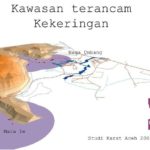SWOT ANALYSIS: BENER MERIAH AND ACEH SINGKIL
November 28th, 2014 | Published in Disaster
Based on SWOT Analysis, here are 14 skenario recommendations to increase the effectivity and efficiency of DRR efforts in Bener Meriah and Aceh Singkil district Bener Meriah is located at 4 ° 33 ‘ 50 ” – 4 ° 54 ‘ 50 ” N and 96 ° 40 ‘ 75 ‘ – 97 ° 17 ‘ 50 ” E with an average of 100-2500 meters above sea level. This district has a population of 128 538 with density of ± 1412.07 people per km2 spread over 10 districts and 233 villages. The geographical position of Aceh Singkil is at 2002’-2027’30” N and 97004’-97045’00” E. With an area of ??2,187 km2, Aceh Singkil area split into 11 districts, 16 mukims, and 120 villages. Bener Meriah and Aceh Singkil district have a very dynamic geological that resulted in a disaster which potentially occur in these districts. Several events related to disaster occurred in the areas which caused considerable losses and victims. In addition, Bener Meriah also has an active volcano that could erupt at any time. These disasters are not caused by nature alone but also non-nature and combination of components threat risk, vulnerabilities, and the inability or weakness in acting to reduce the potential of existing negative consequences. The implementation of disaster management in Bener Meriah and Aceh Singkil requires a well-designed, targeted and integrated planning. This need has been answered by the production of map compiled by Integrated Team of Disaster Risk Map legalized by Decree of Bupati of Bener Meriah No. Peg. 800/ 247/ SK/ 2013 and the Decree of Bupati of Aceh Singkil No. 111 Year 2013 about the Formation of Integrated Technical Team District Disaster Risk Map. Of course, this arrangement is in accordance with the Regulations set by the Head of National Disaster Management Agency (PERKA) Number 02 Year 2012 About General Guidelines for Disaster Risk Analysis in hopes of creating sinergy in implementing an effective disaster management at the central, provincial and district level. On the basis of the disaster risk map, the government of Bener Meriah district has had a Disaster Management Plan document and the district government of Aceh Singkil has had a Flood Contingency Plan document. By having these documents, it is expected that the various parties can harmonize the implementation of disaster management in the Bener Meriah and Aceh Singkil which is made ??possible through the awareness, readiness and ability of the government and the people in an effective, well-coordinated, and efficient system. Based on the cooperation between IOM and Karst Aceh, Karst Aceh management has set Primary goals of this activity as follows:
Overall Objectives
- Strengthening BPBD’s capacity development to enable them to better fulfill their mandate and contribute to the goals of the National DRR.
- Support for integrating disaster actors including government agencies, non-governmental organizations, and communities within the framework of the local disaster management and equip them to prepare for and respond to natural disasters under the coordination of BPBD.
- Synchronization and coordination of planning at the district with BPBA and BNPB for the purpose of disaster risk reduction which has sustainable development vision.
Output The outputs set to achieve the objectives are as follows:
- Conducting Geographic Information System training tostrengthen the capacity oflocalactorsinthe targetdistricts.
- Disaster RiskMappinginthe targetdistricts.
- Disaster Management Plan in Bener Meriah district and Flood Contingency Plan in Aceh Singkil district.
Implementation of Activities Table 1. Detail of Activities
| NO | Detail of Activities | Schedul target | Implementation | Financial | |
| Bener Meriah | Aceh Singkil | ||||
| 1 | Mobilization | 5 Feb 2013 | 2 Feb 2013 | 2 Feb 2013 | 18% |
| 2 | Training GIS | 4 Mar 13 | 20 Mar 2013 | 12 Apr 2013 | 5% |
| 3 | Ground Check Mapping | 3 Apr 2013 | 14 Mar 2013 | 7 Apr 2013 | 4% |
| 4 | DRM Initial | 6 May 2013 | 7 May 2013 | 23 May 2013 | 2% |
| 5 | Field trip clarifying HCV data | 4 Jun 2013 | 23 May 2013 | 4 Jun 2013 | 5% |
| 6 | Formal coordination meeting | 4 Jul 2013 | 26 Jun 2013 | 21 Jun 2013 | 4% |
| 7 | Technical Group Meetings | 1 Aug 2013 | 1 Jul 2013 | 22 Jun 2013 | 7% |
| 8 | DRM finalization&Distribution | 17 Sep 2013 | 15 Jan 2014 | 15 Jan 2014 | 3% |
| 9 | DM Plan Initial Team Meeting | 20 Sep 2013 | 17 Sep 2013 | 17 Sep 2013 | 1% |
| 10 | Collection of data for Aceh Singkil | 15 Sep 2013 | – | 27 Sep 2013 | 1% |
| 11 | Seminar Contingency Plan Singkil | 2 Oct 2013 | – | 22 Oct 2013 | 4% |
| 12 | DM Plan Team Meeting-Bener Meriah | 1 Nov 2013 | 24 Sep 2013 | – | 4% |
| 13 | Workshop Contingency Plan Singkil | 16 Oct 2013 | – | 26 Oct 2013 | 6% |
| 14 | Table Top Exercise-Singkil | 12 Nov 2013 | – | 2 Dec 2013 | 2% |
| 15 | Finalizing Draft DM Plan-Bener Meriah | 8 Dec 2013 | 21 Nov 2013 | – | 4% |
| 16 | Simulation-Singkil | 14 Dec 2013 | – | 28 Feb 2014 | 7% |
| 17 | Public Seminary Bener Meriah | 6 Jan 2014 | 7 Jul 2014 | 2% | |
| 18 | Public Seminary Aceh Singkil | 14 Jan 2014 | – | 12 Mar 2014 | 3% |
| 19 | Finalizing DM Plan-Bener Meriah | 29 Jan 2014 | 19 Feb 2014 | – | 4% |
| 20 | Contingency Plan Finalizing-Singkil | 20 Jan 2014 | – | 17 Mar 2014 | 4% |
| 21 | DM Plan Endorsement-Bener Meriah | 3 Mar 2014 | 29 Apr 2014 | 29 Apr 2014 | 4% |
| 22 | Contingency Plan Endorsement-Singkil | 20 Feb 2014 | 29 Apr 2014 | 29 Apr 2014 | 3% |
| 23 | Final Report | 31 Mar 2014 | 27 May 2014 | 27 May 2014 | 2% |
ANALISA SWOT  Based on lessons learned and obstacles encountered,Karst Determines several variables obtained from internal factor and external factor. Internal factor is set as actors in the district and external factor is Karst Intervention. Based on these two variables, internal factor with positive implication defined as Strength variable and internal factor that has negative implications defined as Weakness variable. In the external factor with positive impact specified as Opportunity variable and external factor that has negative implications designated as Threat variable. Based on the matrix, several strategies are proposed to improve the strength and opportunity and to mitigate weakness and threat that occurred. The strategy is set into 4 indicator factors, namely: Resources; budget; integration; and Guideline.
Based on lessons learned and obstacles encountered,Karst Determines several variables obtained from internal factor and external factor. Internal factor is set as actors in the district and external factor is Karst Intervention. Based on these two variables, internal factor with positive implication defined as Strength variable and internal factor that has negative implications defined as Weakness variable. In the external factor with positive impact specified as Opportunity variable and external factor that has negative implications designated as Threat variable. Based on the matrix, several strategies are proposed to improve the strength and opportunity and to mitigate weakness and threat that occurred. The strategy is set into 4 indicator factors, namely: Resources; budget; integration; and Guideline. 
On the strength variable which is affected by the Resource and Budget, highest outcome is DRR regulations and documents and lowest outcome is newly established DRR forum. On the opportunity variable which affected more by financial factors than integration put good process at the highest outcome and involving BNPB and BPBA as the lowest one. Threat variable which is more influenced by guideline factor than integration puts natural disasters as the lowest cause and regulation uncertainty as the highest cause. For weakness variable which is influenced more by influenced by resource factor rather than guideline placing limited access as the lowest cause and the leadership as the highest weakness cause.
The program strategy that can be done can be seen in the following scheme: 
SCENARIO RECOMMENDATIONS
Based on the analysis, here are 14 skenario recommendations which can be applied to increase the effectivity and efficiency of DRR efforts in Bener Meriah and Aceh Singkil district:
- Preparingcapacity building by involvingBNPB, BPBA, andnon-governmentalpartnersto encouragestrong leadership, supportlocal autonomy in accordance with the regulations, science-based, and accommodatecommunity participation
- Preparing the making of disaster documents such as Regional Action plan and highly potential disaster contingency plan in sinergy with Disaster Management Plan
- Preparing advocacy of regulations and document of Disaster management by involving BNPB, BPBA, and non governmental organizations and encourage the district taskforce and community as the active actors in DRR forum.
- Defining Advocacy of DRR Budget that is integrated into SKPK workplan and/or into APBD
- Defining Companies/Private institutions to create and implement CSR program with a DRR vision and defined in a district regulation and can be audited
- Defining DRR audit towards the working units in district level as well as companies so that the DRR principles can be important aspect in the planning, implementation and evaluation of the development in the district.
- Maintaining roles and commitments of head of district, SKPK, companies, and non governmental organizations in the planning and implementing DRR based programs.
- Maintaining working unit that facilitates and supports the trainings and studies to increase the capacity of human resources which is sinergized in District DRR forum.
- Maintaining the production of maps, data and documents in accordance with existing regulations, science-based and involving community participation.
- Maintaining the disaster simulation to be district agenda in increasing district’s disaster preparedness.
- Preventing the weak leadership and administration which run the program not based on the existing disaster documents.
- Preventing data dan Informasi formulation from the regulations that are unclear, not science-based and does not accommodate community participation.
- Preventing the concentration of disaster budget which focused more on the tools and equipment of emergency response for the institution/disaster actors and it is limited only the socialization to the community.
- Preventing the working unit or DRR forum established without any legalization and working with no sinergy with BPBD, BPBA, and BNPB.



